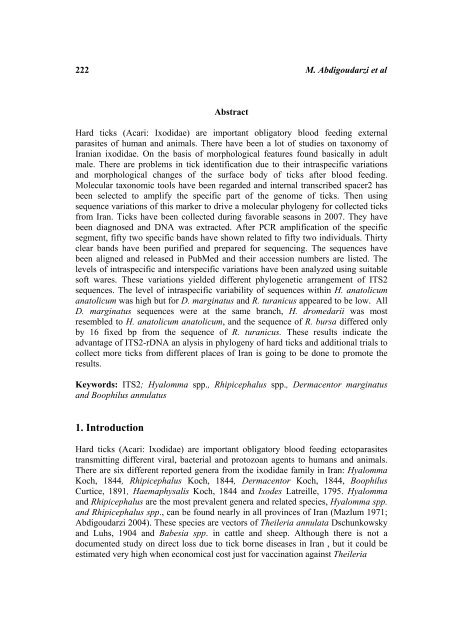rDNA-ITS2 Identification of Hyalomma, Rhipicephalus ... - HIKARI Ltd
rDNA-ITS2 Identification of Hyalomma, Rhipicephalus ... - HIKARI Ltd
rDNA-ITS2 Identification of Hyalomma, Rhipicephalus ... - HIKARI Ltd
Create successful ePaper yourself
Turn your PDF publications into a flip-book with our unique Google optimized e-Paper software.
222 M. Abdigoudarzi et al<br />
Abstract<br />
Hard ticks (Acari: Ixodidae) are important obligatory blood feeding external<br />
parasites <strong>of</strong> human and animals. There have been a lot <strong>of</strong> studies on taxonomy <strong>of</strong><br />
Iranian ixodidae. On the basis <strong>of</strong> morphological features found basically in adult<br />
male. There are problems in tick identification due to their intraspecific variations<br />
and morphological changes <strong>of</strong> the surface body <strong>of</strong> ticks after blood feeding.<br />
Molecular taxonomic tools have been regarded and internal transcribed spacer2 has<br />
been selected to amplify the specific part <strong>of</strong> the genome <strong>of</strong> ticks. Then using<br />
sequence variations <strong>of</strong> this marker to drive a molecular phylogeny for collected ticks<br />
from Iran. Ticks have been collected during favorable seasons in 2007. They have<br />
been diagnosed and DNA was extracted. After PCR amplification <strong>of</strong> the specific<br />
segment, fifty two specific bands have shown related to fifty two individuals. Thirty<br />
clear bands have been purified and prepared for sequencing. The sequences have<br />
been aligned and released in PubMed and their accession numbers are listed. The<br />
levels <strong>of</strong> intraspecific and interspecific variations have been analyzed using suitable<br />
s<strong>of</strong>t wares. These variations yielded different phylogenetic arrangement <strong>of</strong> <strong>ITS2</strong><br />
sequences. The level <strong>of</strong> intraspecific variability <strong>of</strong> sequences within H. anatolicum<br />
anatolicum was high but for D. marginatus and R. turanicus appeared to be low. All<br />
D. marginatus sequences were at the same branch, H. dromedarii was most<br />
resembled to H. anatolicum anatolicum, and the sequence <strong>of</strong> R. bursa differed only<br />
by 16 fixed bp from the sequence <strong>of</strong> R. turanicus. These results indicate the<br />
advantage <strong>of</strong> <strong>ITS2</strong>-<strong>rDNA</strong> an alysis in phylogeny <strong>of</strong> hard ticks and additional trials to<br />
collect more ticks from different places <strong>of</strong> Iran is going to be done to promote the<br />
results.<br />
Keywords: <strong>ITS2</strong>; <strong>Hyalomma</strong> spp., <strong>Rhipicephalus</strong> spp., Dermacentor marginatus<br />
and Boophilus annulatus<br />
1. Introduction<br />
Hard ticks (Acari: Ixodidae) are important obligatory blood feeding ectoparasites<br />
transmitting different viral, bacterial and protozoan agents to humans and animals.<br />
There are six different reported genera from the ixodidae family in Iran: <strong>Hyalomma</strong><br />
Koch, 1844, <strong>Rhipicephalus</strong> Koch, 1844, Dermacentor Koch, 1844, Boophilus<br />
Curtice, 1891, Haemaphysalis Koch, 1844 and Ixodes Latreille, 1795. <strong>Hyalomma</strong><br />
and <strong>Rhipicephalus</strong> are the most prevalent genera and related species, <strong>Hyalomma</strong> spp.<br />
and <strong>Rhipicephalus</strong> spp., can be found nearly in all provinces <strong>of</strong> Iran (Mazlum 1971;<br />
Abdigoudarzi 2004). These species are vectors <strong>of</strong> Theileria annulata Dschunkowsky<br />
and Luhs, 1904 and Babesia spp. in cattle and sheep. Although there is not a<br />
documented study on direct loss due to tick borne diseases in Iran , but it could be<br />
estimated very high when economical cost just for vaccination against Theileria
















